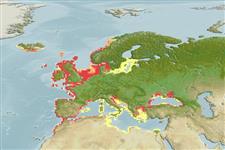Preferred temperature (Ref.
123201): 8.4 - 19.5, mean 11.2 °C (based on 472 cells).
Índice de diversidade filogenética (Ref.
82804): PD
50 = 0.5645 [Uniqueness, from 0.5 = low to 2.0 = high].
Bayesian length-weight: a=0.01096 (0.00893 - 0.01346), b=3.01 (2.95 - 3.07), in cm total length, based on LWR estimates for this species (Ref.
93245).
Nível Trófico (Ref.
69278): 4.4 ±0.1 se; based on diet studies.
Generation time: 4.1 ( na - na) years. Estimated as median ln(3)/K based on 2
growth studies.
Resiliência (Ref.
120179): médio(a), tempo mínimo de duplicação da população 1,4 - 4,4 anos (tm=3-5; tmax=6).
Prior r = 0.47, 95% CL = 0.31 - 0.70, Based on 5 full stock assessments.
Fishing Vulnerability (Ref.
59153): Moderate vulnerability (36 of 100).
🛈
Climate Vulnerability (Ref.
125649): Moderate to high vulnerability (54 of 100).
🛈
Nutrients (Ref.
124155): Calcium = 37.7 [14.9, 70.5] mg/100g; Iron = 0.174 [0.061, 0.770] mg/100g; Protein = 19.3 [17.8, 20.8] %; Omega3 = 0.262 [0.140, 0.491] g/100g; Selenium = 14 [6, 33] μg/100g; VitaminA = 8.74 [1.87, 40.75] μg/100g; Zinc = 0.145 [0.082, 0.500] mg/100g (wet weight); based on
nutrient studies. 